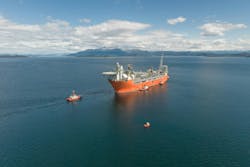Johan Castberg FPSO sets sail for Barents Sea
Production from the Equinor-operated Johan Castberg field is inching closer to startup with sail away of the Johan Castberg floating production, storage and offloading (FPSO) vessel from Klosterfjorden on the Norwegian west coast.
The start of the 220,000 boe/d FPSO's 1,000 nautical-mile journey to the Barents Sea was noted in official LinkedIn posts by both Equinor and project partner Vår Energi ASA Aug. 23, Startup is scheduled for this year’s fourth quarter.
Johan Castberg field lies about 100 km north of Snøhvit field in the Barents Sea. The resource base consists of three Equinor-operated oil discoveries—Skrugard (2011), Havis (2012), and Drivis (2014)—all in production license 532. The field is expected to produce for 30 years.
The reservoirs contain oil with gas caps in three separate sandstone deposits from Late Triassic to Middle Jurassic age in the Tubåen, Nordmela, and Stø formations at a depth of 1,250-1,900 m, according to the Norwegian Offshore Directorate (NOD).
Johan Castberg development, challenges
The field will be developed through a total of 30 wells distributed across 10 subsea templates and two satellite structures. Expected recoverable resources are estimated at 450-650 MMboe.
Operations of Johan Castberg will be handled using a supply and helicopter base in Hammerfest and an operating organization in Harstad.
Field development at Johan Castberg provides infrastructure for what is considered a new oil province in the Barents Sea, Equinor has said, but the project has met with a few challenges over the years.
Late last year, the Johan Castberg partnership increased the project’s investment estimate by almost NOK 13 billion ($1.2 billion) from the prior year to nearly NOK 80 billion (OGJ Online, Sept. 19, 2023). Cost overruns were blamed on a tighter supplier market and an increased work scope in Norway following the FPSO hull mobilization from Singapore to Stord.
In early 2015, the operator (then named Statoil ASA) and partners postponed Johan Castberg development decisions to cut costs (OGJ Online, Mar. 6, 2015). The year before, the partners elected to “spend more time on making the final concept selection” for the project (OGJ Online, June 20, 2014). A plan for the development and operation (PDO) was eventually submitted to Norwegian authorities in 2017 (OGJ Online, Dec. 5, 2017).
According to Equinor, the Johan Castberg project is expected to “strengthen Norway’s role as a reliable and long-term energy supplier.”
In addition to the current three-field resource base, five additional discoveries are being considered as tie-ins to Johan Castberg with more exploration plans expected in the years to come (OGJ Online, June 9, 2022; May 25, 2022; Mar. 10, 2021).
Equinor is operator with 50% interest. Partners are Vår Energi (30%) and Petoro AS (20%).
About the Author
Mikaila Adams
Managing Editor, Content Strategist
Mikaila Adams has 20 years of experience as an editor, most of which has been centered on the oil and gas industry. She enjoyed 12 years focused on the business/finance side of the industry as an editor for Oil & Gas Journal's sister publication, Oil & Gas Financial Journal (OGFJ). After OGFJ ceased publication in 2017, she joined Oil & Gas Journal and was later named Managing Editor - News. Her role has expanded into content strategy. She holds a degree from Texas Tech University.

